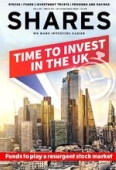Archived article
Please note that tax, investment, pension and ISA rules can change and the information and any views contained in this article may now be inaccurate.
Is the US headed for a hard or soft landing in 2023?

American musician and bandleader Frank Zappa once asserted that: “The mind is like a parachute. It doesn’t work if it isn’t open.’ Investing is surely just the same. No-one has a crystal ball and financial markets are at their most volatile – and therefore ripe with opportunity – when consensus opinions are coming under duress. Mood follows price and both the bull and bear case always seem most compelling at, or at least near, the peak and trough respectively.
This is why the debate over whether the US is going to go into recession in 2023 matters. Right now, share prices are assuming that inflation will gently decelerate, interest rate hikes will stop and then become rate cuts and as a result the world’s economic powerhouse will suffer nothing worse than a soft landing, or even start to soar once more after avoiding an encounter with the ground altogether.
If so, then all may be well and good. But what if the consensus is wrong and such a glorious hat-trick does not fall into investors’ laps? Applying Zappa’s maxim, it must be at least worth looking out for possible danger signs and considering what could go wrong if the core scenario does not develop as anticipated. Where the US goes, the world tends to follow, after all.
Back to the future
One useful exercise may be to try and block
out 2020 to 2022 altogether, given the extraordinary challenge posed by Covid-19 and the massive amount of monetary and fiscal stimulus (let alone scientific research) that were deployed to beat
it off.
Think back to 2019. The US economy was losing momentum and then president Trump was trying to goose it into life before 2020’s election, not least by leaning on the Federal Reserve to keep policy loose. It can be argued that the US is now returning to that trajectory as the Fed steps away from ultra-loose policy, Capitol Hill stops authorising stimulus cheques and the debt taken on during 2020-22 starts to weigh.
One of this column’s preferred indicators, the Dow Jones Transportation index, was going nowhere fast in 2019 and it has lost momentum over the past year. The benchmark has thus far failed to recapture its November 2021 high, even after a furious rally from the autumn low. This is worth bearing in mind if Dow Theory holds good, and the Industrials index follows where its Transports counterpart goes.
Dollars and cents
Most tangibly of all, US corporate profits are starting to feel the strain.
A year ago, analysts were looking for aggregate earnings per share (EPS) from the S&P 500 index of $225, up from $198 in 2021, with further progress to $247 in 2023. Consensus forecasts now think earnings fell in 2021, to $197, while 2023 estimates are down to $220. If the US economy does hit a bump, then even 12% earnings growth this year could be hard to achieve, even allowing for some of the fierce cost-cutting already in evidence at some of America’s largest corporations.
Those earnings forecast downgrades help to explain why the S&P 500 is still lower than it was at this time last year. A soft landing or unexpected growth could quickly cure the ills that trouble corporate earnings and boost the index, but a sharp downturn could put earnings forecasts, and the benchmark, under more pressure.
Granted, investors still think the US Federal Reserve can save the day with interest rate cuts, and they may well be right. But history shows the Fed starts to cut only once something has snapped – the economy, the markets or both – and frantic rate cutting did not provide immediate succour in either of the 2000-03 or 2007-09 bear markets.
Important information:
These articles are provided by Shares magazine which is published by AJ Bell Media, a part of AJ Bell. Shares is not written by AJ Bell.
Shares is provided for your general information and use and is not a personal recommendation to invest. It is not intended to be relied upon by you in making or not making any investment decisions. The investments referred to in these articles will not be suitable for all investors. If in doubt please seek appropriate independent financial advice.
Investors acting on the information in these articles do so at their own risk and AJ Bell Media and its staff do not accept liability for losses suffered by investors as a result of their investment decisions.
Issue contents
Editor's View
Feature
- Revealing the bargain stocks which may have been left behind
- Time to invest in the UK: funds to play a resurgent stock market
- Discover the funds and stocks which pay monthly and quarterly incomes
- The £5 investment challenge. Get on board and invest a little bit more each month
- Emerging markets: a cold winter for China and growth back in favour
- Discover the emerging markets stocks picked out as growth champions
Great Ideas
News
- Big banks fail to live up to the market’s high expectations
- How US retail titans Walmart and Home Depot disappointed investors
- Darktrace calls in EY as it mounts fight against big fraud claims
- Why billionaire Ken Griffin is backing the Boohoo recovery plan
- LADbible owner LBG Media more than doubles after strong trading and broker optimism
- Trainline shares down 30% in six months with recovery derailed by strikes
 magazine
magazine








